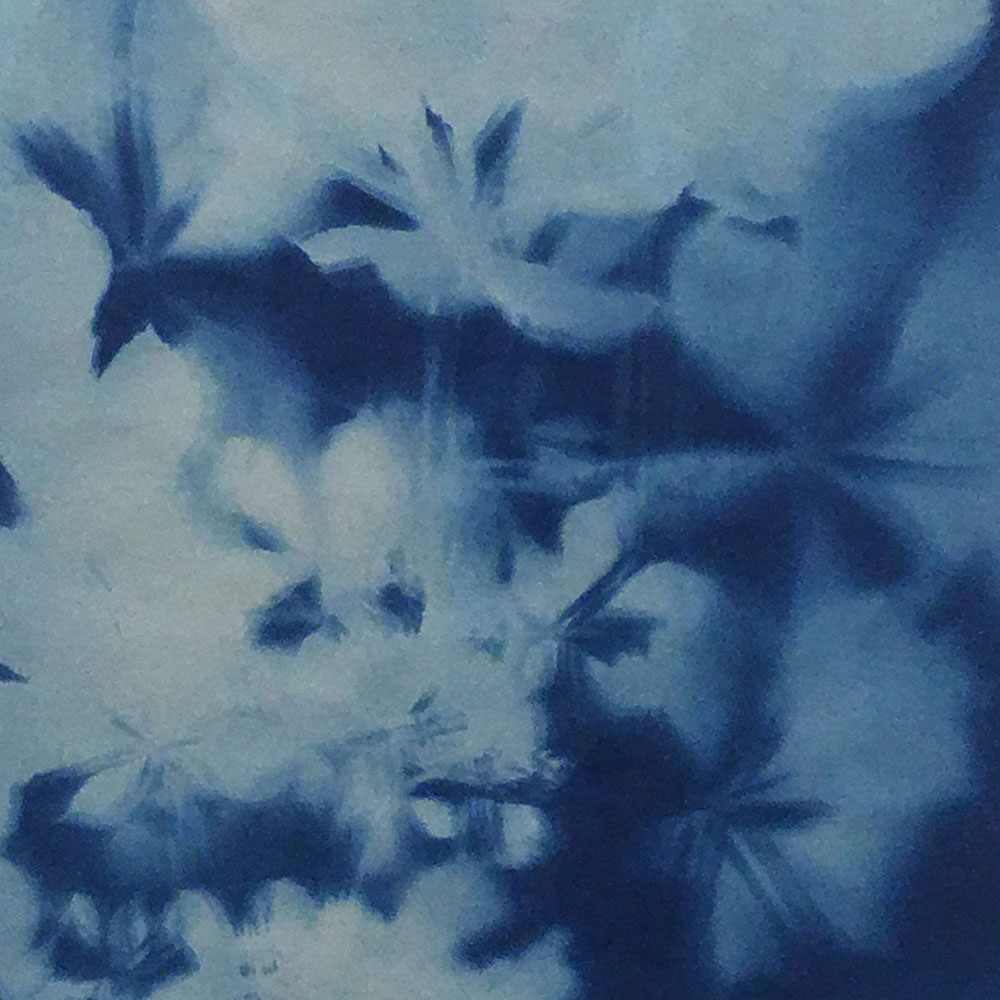
Tom Fels, Chestnut, 2016
Tom Fels: Light & Shadow — Cyanotypes and Drawings
January 7 – February 7, 2016
Opening Reception: Thursday, January 7, 5 -7pm
Artist Talk: Friday, January 22, 5pm.
Prints from the Arbor, Catalpa and Other Series
cyanotypes on paper, 3 x 2 ft., 2011-2014
Tom Fels’ cyanotype series stem from his lengthy engagement with a single subject: a tree in his garden and its dappled shadows. Previously he had addressed these through pencil drawings and photographs. The discovery of the availability of large-scale cyanotype paper in the summer of 2011 took the experience in a new direction.
The cyanotype is an early process of great simplicity and unique color (a deep blue, cyan). Typically, the method has been employed to produce silhouettes – of leaves, for example, as in the botanical illustrations of the pioneer British photographer Anna Atkins (1799-1871) – but the same process was also used to make photographic prints from negatives, as well as architectural blueprints.
Fels’ cyanotypes are cameraless photographs, popularly called “sun prints” or “shadow prints.” There is no negative; each is unique. The prints are life-sized, 1:1 scale renderings of their natural subject matter. The Arbor, Catalpa and other series shown here are at once empirical and romantic. The result of a technical process dependent on light and chemistry alone, these prints can be regarded on one level as simply unmanipulated records of the organic world. On another they are richly suggestive, capturing a deeply evocative sense of motion and form. A recent review in the Boston Globe observed that they “evoke the touch and movement of a friendly breeze.”
Drawings from the Linea Series
graphite on paper, various dimensions, 2014-2015
The drawings shown here are from a series developed in a style with which Fels has been working for some years, including use in wall drawings. Though developed independently, they reflect an appreciation of Agnes Martin, Sol Lewitt, and others working in a linear, minimalist vein. While composed entirely of straight parallel lines arranged in orderly geometric shapes, another level of interest lies in the slight variations and tensions between the individual strokes that make up the freehand grids.
Cyanotype – A Definition
One of several types of early photographic print which emerged from the circle of pioneer photographer Henry Fox Talbot was the cyanotype. This characteristically blue, or cyan, print on paper substituted iron salts for those of silver, and was produced by a process of oxidation. Being considerably simpler, and requiring only a water bath for development, it was employed by amateurs and others seeking a less difficult means of reproduction. While its striking deep blue color limited its aesthetic applications, its use in botany, as in the volumes of British flora assembled by early photographer Anna Atkins beginning in 1843, produced some very attractive works. It is best known today as the forerunner of the blueprint process through which architectural and other technical drawings are reproduced. Albums and individual prints are sometimes found in which photographers used the medium in the same way – to record images from negatives for study or archival use. Occasionally, both earlier in the twentieth century and now again in the current era, cyanotype is employed for its aesthetic value alone. As a non-silver process, cyanotypes are resistant to fading.
From Thomas Weston Fels, Sotheby’s Guide to Photographs, New York, Henry Holt and Company, 1998.
__________________
For more than thirty years Tom Fels has been a curator and writer specializing in the history of photography. He has organized exhibitions at the Getty Museum in Malibu, the van Gogh Museum in Amsterdam, and many other institutions, especially in California and the Northeast. His books on the subject include O Say Can You See: American Photographs 1839-1939 (1989), Sotheby’s Guide to Photographs (1998), and Fire and Ice: Treasures from the Photographic Collection of Frederic Church (2002). Fels has also written two highly acclaimed books on the 1960s, Farm Friends: From the Late Sixties to the West Seventies (2008) and Buying the Farm: Peace and War on a Sixties Commune (2012). He began showing his recent art in the Northeast in 2013. Concurrent with the present show his cyanotypes are being shown in Light Works: The Art of the Photogram at the Atlas Gallery, London. Cyanotypes from the Arbor and Catalpa Series are now represented in several museum and private collections, including the collection of the Museum of Fine Arts, Boston.
